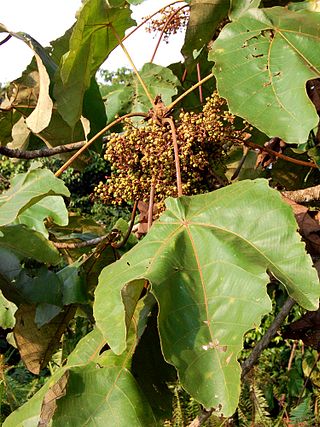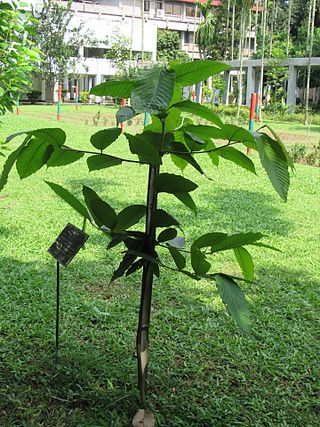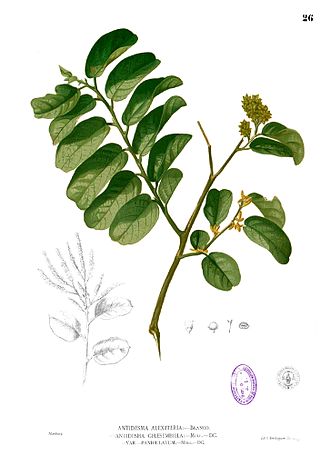
Mallotus is a genus of the spurge family Euphorbiaceae first described as a genus in 1790. Two species are found in tropical Africa and Madagascar. All the other species are found in East Asia, the Indian Subcontinent, Southeast Asia, eastern Australia, and certain islands of the western Pacific. The genus has about 150 species of dioecious trees or shrubs.

Macaranga is a large genus of Old World tropical trees of the family Euphorbiaceae and the only genus in the subtribe Macaranginae. Native to Africa, Australasia, Asia and various islands of the Indian and Pacific Oceans, the genus comprises over 300 different species. It was first described as a genus in 1806, based on specimens collected on the Island of Mauritius.

Asimina triloba, the American papaw, pawpaw, paw paw, or paw-paw, among many regional names, is a small deciduous tree native to the eastern United States and southern Ontario, Canada, producing a large, yellowish-green to brown fruit. Asimina is the only temperate genus in the tropical and subtropical flowering plant family Annonaceae, and Asimina triloba has the most northern range of all. Well-known tropical fruits of different genera in family Annonaceae include the custard-apple, cherimoya, sweetsop, ylang-ylang, and soursop.

Danum Valley Conservation Area is a 438 square kilometres tract of relatively undisturbed lowland dipterocarp forest in Sabah, Malaysia. It has an extensive diversity of tropical flora and fauna, including such species as the rare Bornean orangutans, gibbons, mousedeer, clouded leopards and over 270 bird species. Activities offered are jungle treks, river swimming, bird watching, night jungle tours and excursions to nearby logging sites and timber mills.

Borneo is the third largest island in the world. In prehistoric times it was connected to the Asian mainland due to geological and climate changes. During the recent ice ages of the Pleistocene and the Holocene separation from the mainland caused extinctions and speciation of fauna on the island.

The wildlife of Malaysia is diverse, with Malaysia being a megadiverse country. Most of the country is covered in rainforest, which hosts a huge diversity of plant and animal species. There are approximately 361 mammal species, 694 bird species, 250 reptile species, and 150 frog species found in Malaysia. Its large marine territory also holds a great diversity of life, with the country's coastal waters comprising part of the Coral Triangle.

The Lambir Hills National Park is a national park in Miri Division, Sarawak, Malaysia, on the island of Borneo. It is a small park, at 6,952 hectares, and is composed largely of mixed dipterocarp forest, with some small areas of 'kerangas'. The park is 150–465 m (492–1,526 ft) above sea level.

Shorea leprosula is a species of tree in the family Dipterocarpaceae. It is native to Sumatra, Borneo, Peninsular Malaysia, Java, and Thailand.

Betung Kerihun National Park is a national park located in the Indonesian province of West Kalimantan, on the island of Borneo. The park was established in 1995, and has a total area of 8,000 km2 (3,100 sq mi) or about 5.5 percent of West Kalimantan Province area. Together with the 2,000 km2 (800 sq mi) Lanjak Entimau Wildlife Sanctuary in Malaysia, it has been proposed to form a World Heritage Site named the "Transborder Rainforest Heritage of Borneo".

Macaranga gigantea is a pioneer tree species from western Indo-China and Malesia including Sulawesi.

The Borneo lowland rain forests is an ecoregion, within the tropical and subtropical moist broadleaf forests biome, of the large island of Borneo in Southeast Asia. It supports approximately 15,000 plant species, 380 bird species and several mammal species. The Borneo lowland rain forests is diminishing due to logging, hunting and conversion to commercial land use.

Dipterocarpus turbinatus is a species of tree in the family Dipterocarpaceae native to north-eastern India and mainland Southeast Asia, and cultivated in surrounding regions. It is an important source of the wood known as keruing, and is often used in the plywood industry.
Diospyros venosa is a tree in the family Ebenaceae. It is native to Southeast Asia, from the Maluku Islands to Myanmar. It provides raw material for handicrafts, traditional medicine and fuel.

Antidesma ghaesembilla is a species of plant in the Phyllanthaceae family. It is native to an area from northern Australia to the Philippines, China, and west to India. The shrub or tree usually grows in moist soils in plant communities ranging from savannah to gallery forest to closed forest. It is associated with a number of species of fungus, insects and animals, including emus. Amongst the Mangarrayi and Yangman people of north Australia, the sweet ripe fruit of the tree are much appreciated and linked to the build-up season and to the koel. As well as food, the plant is used as a calendar-plant, for dyeing, in traditional medicine, in religious/magical practices, as fuel, and as an insecticide.
Shorea parvifolia is a species of tree in the family Dipterocarpaceae, commonly known as light red meranti and white lauan. It is native to tropical southeastern Asia.
Pentace laxiflora is a species of flowering plant in the family Malvaceae sensu lato or Tiliaceae. It is a tree endemic to Borneo. Its conservation status has been listed by the International Union for Conservation of Nature as being of least concern.
Aporosa ficifolia is a species of shrub in the family Phyllanthaceae. It grows 2-8m tall, it has a restricted habitat, growing in lowland open or pine forests up to 700m elevation.
Mallotus plicatus is a tree or shrub in the Euphorbiaceae family, in the Polyadenii section. It occurs in much of Mainland Southeast Asia. It is used for dyeing and in construction.
Pimelodendron amboinicum is a tree species in the Euphorbiaceae family. It is found from the Solomon Islands in the southwest Pacific, west to Sulawesi in Indonesia. The timber is used locally, though larger-scale illegal logging is apparent.
Macaranga novoguineensis is a species of tree in the Euphorbiaceae family. It is native to New Britain and New Guinea. It is a late succession plant, and supports a variety of insect herbivores, including caterpillars from the moth Homona mermerodes.


















